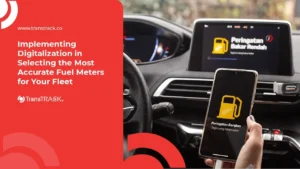Utilization of TransTRACK GPS Tracker Analytics Data for Fleet Efficiency
Posted on September 30, 2024 by Nur Wachda Mihmidati

Analytics data plays an important role in fleet monitoring through GPS Tracker. The Global Positioning Systems (GPS) market in the Asia Pacific region is projected to experience significant growth between 2024 and 2034. In 2023, the GPS market size in the region was valued at USD 34.87 billion, and is expected to reach approximately USD 174.70 billion by 2034, with an annual growth rate (CAGR) of 16%.
By 2023, Asia Pacific holds a 37% share of the global GPS market, driven by rapid economic growth, extensive infrastructure development, as well as the widespread adoption of GPS technology across various industries. Growing demand for location-based services, advancements in automotive navigation, and expansion of the precision agriculture sector are the key drivers of this growth.
In addition, the region’s booming automotive sector, along with smart city initiatives and increased technology investments, is further strengthening the adoption of GPS solutions. Initiatives such as these not only help accelerate the digital transformation in Asia Pacific, but also position the region as a leader in the global GPS market, with significant contributions to increased operational efficiency and improved location-based services across various sectors.
With strong growth prospects and growing opportunities, Asia Pacific will continue to play a pivotal role in driving the global GPS market over the next decade.

Market Dynamics
Key Drivers: Expansion of Automotive Navigation Systems
The growth of the global GPS market is driven by the expansion of automotive navigation systems that widely integrate GPS technology. By 2021, more than 100 million cars worldwide will be equipped with embedded navigation systems, and demand for this technology continues to rise. Automotive navigation systems provide real-time location information, directions, and better traffic management, improving the overall driving experience. In addition, consumers are increasingly seeking advanced navigation features and connected car services, driving the automotive industry to adopt GPS technology.
The expansion of automotive navigation systems not only improves the driving experience, but also supports the development of autonomous vehicles and driver assistance systems (ADAS). With the rapid development of autonomous vehicles, the need for accurate positioning and navigation becomes more important, which in turn increases the demand for GPS solutions. These factors contribute greatly to the success and expansion of the GPS market.
Barriers: Dependence on Satellite Constellations
One of the major challenges in the global GPS market is the dependency on satellite constellations. GPS relies on a network of satellites to provide accurate position information. Disruptions, damage or failures in the satellite constellation can affect the availability and reliability of GPS services. These vulnerabilities pose a risk of service outages, which could have a wide-ranging impact on a variety of industries that rely heavily on accurate navigation and location analytics data.
This reliance emphasizes the importance of improving satellite reliability and developing contingency plans to mitigate this risk. As demand for GPS increases, maintaining the resilience of the satellite network is critical for this technology to remain trusted and widely used in sectors such as transportation, agriculture, and defense.
Opportunities: Integration of GPS with New Technologies
The integration of GPS with new technologies such as artificial intelligence (AI), machine learning, and the Internet of Things (IoT) creates huge opportunities for market growth. AI and machine learning algorithms can use GPS analytics data to provide predictive insights, improve route optimization, and enable smart navigation solutions. In addition, integration with IoT enables real-time asset tracking and monitoring, making GPS an integral part of the connected ecosystem across industries such as logistics, transportation, and smart cities.
These advancements not only improve the accuracy and efficiency of GPS, but also pave the way for new applications in various sectors. As businesses and industries continue to explore the potential of this technology, the GPS market will benefit greatly, offering solutions that go beyond traditional navigation, but also smart and innovative data analytics-based services.
App Insights: Growth of Location-Based Services and Road Navigation
The location-based services segment held the highest market share of 45% by 2023. The integration of location-based features in social media platforms, allowing users to share locations through geotagged posts, has become a common practice. This trend increases user engagement and contributes to the importance of location-based services. Location-based services also play an important role in e-commerce, allowing businesses to offer personalized services, promotions, and advertisements based on a user’s location. IoT uses GPS technology for location tracking in various applications, including asset tracking, smart city initiatives, and connected devices.
The road segment is expected to experience rapid growth at a CAGR of 16.8% during the projected period. In the GPS market, this segment refers to the application of GPS technology in navigation and traffic management for roads. GPS devices in vehicles provide real-time location analytics data, directions, and traffic updates, improving road safety and efficiency. An important trend in this segment is the integration of GPS with driver assistance systems (ADAS) for features such as lane departure warning and collision avoidance.
Deployment Insights: Rapid Growth in Consumer Devices and Automotive Telematics Segments
The consumer devices segment holds a market share of 46% by 2023. This segment includes the application of GPS technology in devices designed for personal use such as smartphones, smartwatches, fitness trackers, and other portable devices. The demand for location-based services in consumer electronics continues to increase. Consumers increasingly want GPS-enabled devices for navigation, fitness tracking, and geotagging on social media. As the integration of GPS technology in consumer devices becomes more standardized, this market continues to emphasize the importance of convenience and real-time location-based functionality.
The automotive telematics systems segment is expected to experience rapid growth during the projected period. Automotive telematics systems utilize in-vehicle GPS technology for real-time tracking, communication, and transmission of data used for data analytics. This segment is experiencing a growing trend as more vehicles integrate advanced telematics features. Modern telematics systems offer services such as vehicle diagnostics, navigation, and connectivity, which enhance driver safety and provide valuable insights for vehicle maintenance. Growing demand for connected cars and increasing emphasis on driver assistance technologies are contributing to the growth of this segment within the GPS market.
TransTRACK GPS Tracker Top Features: The Optimal Solution for Fleet Monitoring
TransTRACK’s GPS Tracker is designed to provide a comprehensive solution for real-time fleet monitoring and management. Here are the key features of the TransTRACK GPS Tracker:
- Real-Time Tracking TransTRACK GPS Tracker enables live monitoring of vehicle location. It provides full visibility into fleet movements, so companies can monitor vehicle positions anytime and anywhere. This information is essential for improving operational efficiency and reducing the possibility of route deviations.
- Geofencing This feature allows users to create virtual geographical boundaries. When a vehicle enters or exits the designated area, the system will send a notification. This feature is very helpful to keep the fleet within the planned path and prevent the use of vehicles outside the authorized area.
- Trip Analytics and Analysis Reports TransTRACK provides comprehensive trip reports, including travel time, routes traveled, speed, and stop times. These reports can be used to evaluate driver performance, optimize routes, and identify opportunities for fuel cost and time savings.
- Driver Behavior Monitoring Feature, which records driving habits such as excessive speed, sudden braking, or rapid acceleration. This information helps improve driver safety and minimize the risk of accidents.
- Notifications and Alerts The system allows the setting of automated alerts, such as vehicle service alerts, maintenance reminders, or notifications if a vehicle breaks the speed limit. This ensures the fleet remains in optimal condition and minimizes downtime.
- Integrated with Fleet Management System (FMS), which makes fleet management easy from a single unified platform. Users can manage maintenance schedules, monitor fuel usage, and ensure driver compliance with applicable rules.
- Additional Security with E-seal GPS Trackers from TransTRACK can be equipped with E-seal technology that uses RFID cards. This feature ensures that the vehicle and cargo are protected from unauthorized access, by monitoring every time the vehicle door is opened or closed.
With these features, TransTRACK’s GPS Tracker is a reliable solution for companies looking to improve the visibility, efficiency, and security of their fleet.
Topic :
Recommended Articles

 Bahasa Indonesia
Bahasa Indonesia








